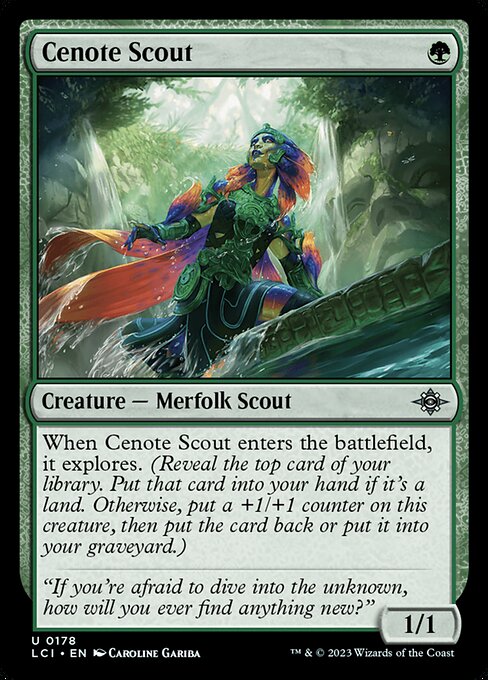
Image courtesy of Scryfall.com
Cenote Scout: Exploring a Lore-Fueled Return to Ixalan’s Hidden Depths
On the surface, Cenote Scout is a modest one-mana Green creature—a 1/1 Merfolk Scout whose real power lies in the moment it enters the battlefield. When it appears, the card invites you to “explore” the top of your library: reveal it, then decide what to do with that peek. If the top card is a land, it flows into your hand; if not, Cenote Scout grows a little, gaining a +1/+1 counter, and you’re free to either leave that revealed card where it is or send it to the graveyard. It’s a compact ritual of risk and reward that embodies Ixalan’s treasure-hunting spirit. 🧙🔥💎
The Lost Caverns of Ixalan, Cenote Scout’s home set, leans into a world where lush underwater caverns hide secrets beneath sun-dappled rivers. The lore version of this card, if you picture it through the prism of flavor text and art, centers on diving into the unknown to discover something new—literally and figuratively. Its flavor line—“If you're afraid to dive into the unknown, how will you ever find anything new?”—speaks to a broader MTG theme: growth comes from stepping into uncharted waters, whether that’s a new land, a new mechanic, or a new deck archetype. The artwork by Caroline Gariba captures a merfolk scout gliding through green-lit currents, the cavern walls buckling with iridescent growth, a sensory reminder that exploration is its own reward. 🎨
“If you're afraid to dive into the unknown, how will you ever find anything new?”
From a gameplay perspective, Cenote Scout is a thoughtful bridge between early pressure and late-game inevitability. Green’s natural tempo is on display here: a cheap body that unlocks exploration, enabling you to snatch a land into hand for mana fixing or ramp, while also scaling itself up if the top card isn’t a land. That dual-path exploration—land advantage or growth—reflects a key theme of Ixalan’s undersea caverns: every path offers treasure, but the true prize may be the distance you can push your creatures once you’ve found the right stones to step on. In formats where you can reliably play a turn-1 or turn-2 green spell, Cenote Scout sets up a flexible play pattern that rewards thoughtful sequencing and careful card evaluation. ⚔️
Original Lore, Modern Play: Why Cenote Scout Still Feels Fresh
The original lore version behind Cenote Scout paints a picture of merfolk who trust their instincts in subterranean watercourses, mapping ancient waterways while avoiding the pitfalls of darkness and pressure. In Ixalan’s mythical ecosystem, cenotes are not just curiosities; they’re gateways—a literal and metaphorical doorway to discovery. That sense of venturing into a hidden world resonates with players who love the “explore” mechanic as a means of information gathering. The moment you flip over the top card, you’re making a choice about what your deck will reveal next: a land to smooth your mana curve, or a nonland that will bolster Cenote Scout’s courage and size. The flavor text serves as a gentle reminder that curiosity isn’t reckless—it’s a deliberate, tactical impulse. 🧭
For collectors and lore enthusiasts, Cenote Scout offers a neat intersection of art, story, and playability. It’s a reminder that MTG’s green creatures can be every bit as thematic as their multicolor siblings, especially when the setting is as evocative as Ixalan’s sunken caverns. The card’s rarity—uncommon—fits its utility: not a slam-dunk pick, but a reliable piece that can slot into a broader explore or +1/+1 counter theme without dominating the board. And yes, the flavor connection to cenotes makes for delightful storytelling when you describe your draws to friends around the table. 🧙♂️
Strategic Angles: Building Around Cenote Scout
- Early pressure with flexibility: On turn one or two, Cenote Scout’s presence can pressure opponents while you peel lands for mana. If the top card is a nonland, the scout grows and you continue to apply pressure, setting up stronger turns as your board fills in green spells and utility lands.
- Explore synergy: The explore mechanic is a micro-tempo engine. Lands in hand provide immediate ramp and land drops, while nonlands can catalyze your creature’s growth for a more resilient threat in the midgame.
- Deck-building considerations: Cenote Scout shines in decks that lean into exploration or +1/+1-counter subthemes. Pair it with cards that reward drawing or searching for lands, and you’ll maximize the value of that top-deck reveal while keeping your options open for the reveal’s fate.
- Color identity and archetypes: As a green creature with a straightforward mana cost, Cenote Scout slots nicely into green-based midrange and ramp shells that enjoy the tempo swing of a growing body on a single mana investment.
In the grand tapestry of MTG lore and deck design, Cenote Scout stands as a compact treasure-hunt narrative: a single, nimble merfolk that invites you to trust your instincts and dive deeper. The Lost Caverns of Ixalan may be a pocket dimension of dappled light and hidden paths, but its lessons translate cleanly to the tabletop: knowledge is power, exploration pays off, and sometimes the best play is to take a small step into the dark and see what glimmers back. 🧙🔥
As you plan your next Ixalan-inspired build, consider pairing Cenote Scout with other explore and landfall-style cards, and let the cavernous atmosphere of the Lost Caverns guide your strategy. If you’re a collector, the card’s non-foil and foil finishes both capture the art and celebrate the theme in a tangible way, even if the market price hovers modestly around a few dimes. The flavor, the mechanics, and the art all align to celebrate the thrill of discovery—on the battlefield and in the library alike. 💎
More from our network
- https://transparent-paper.shop/blog/post/leverage-social-proof-to-increase-digital-download-sales/
- https://transparent-paper.shop/blog/post/the-rise-of-ai-powered-personalization-for-everyone/
- https://blog.digital-vault.xyz/blog/post/clamperl-comedy-parody-moments-in-pokemon-games/
- https://blog.digital-vault.xyz/blog/post/designing-lifestyle-themed-digital-wallpaper-sets-for-everyday-style/
- https://transparent-paper.shop/blog/post/blue-white-giant-in-sagittarius-reveals-milky-way-depths/